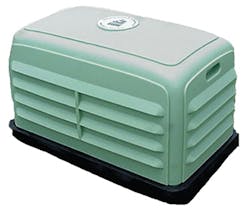Cleaning a Water System With Automatic Flushing Technology
Birmingham Water Works Board (BWWB) of Birmingham, Ala., has consistently achieved the rating of the number-five water system in the United States for water quality. Its potable water distribution system (WDS) serves 600,000 people with a daily average use of 100 million gal (378 million liters) of water, received from nearby lakes and rivers. The system includes 51 water storage tanks, nearly 4,000 miles (6,437 km) of pipe, more than 13,000 fire hydrants and more than 200,000 service connections.
Flushing Processes
BWWB’s water quality standards require routine flushing to restore and improve the quality of the water. Flushing is a normal process performed to reduce water age and associated effects, such as biofilm buildup, disinfectant byproduct contamination and stagnation.
- Routine flushing and unidirectional flushing are critical to the maintenance of water quality within the WDS, as well as the removal of sediment from water mains throughout the WDS. Both are commonly utilized in areas known for low chlorine residuals or areas of frequent customer complaints related to discoloration, odor and/or taste.
- Conventional system flushing consists of flushing fire hydrants and blow-offs in response to customer complaints of poor water quality. As complaints are received, BWWB’s Water Quality Department (WQD) asks specific questions to determine the severity and legitimacy of the issues. If issues cannot be solved within this context, a field technician is deployed and customer locations are visited to remedy the problem
- Advanced maintenance flushing, utilizing a state-of-the-art scheduled and continual system, provides several benefits not possible with conventional flushing techniques:
- Travel time and onsite man-hours are reduced, as flushing in critical locations is automated;
- Units can be programmed to run at times of low water usage and to flush as often as desired at times that are less disruptive to homeowners and businesses; and
- Water is allowed to move continuously through the WDS while keeping chlorine residuals within regulatory compliance parameters.
The Challenge
Alabama State regulations require that BWWB’s WQD maintain a chlorine residual of 0.2 ppm in its water at all times. However, WQD learned that although it routinely flushed certain sites, the required residual was extremely difficult to maintain. It also had to leave several flush points running continuously, resulting in the loss of tremendous amounts of non-revenue water. Additionally, since the city was undergoing drought conditions, BWWB was forced to issue water restrictions that curtailed routine flushing in order to save water, further exacerbating the challenge to maintain the 0.2-ppm chlorine residual. Finally, these issues necessitated the expense of large numbers of staff hours, adding to revenue loss.
The Solution
Through a rigorous search for best solutions, BWWB learned of the Hydro-Guard HG-2 low-profile flushing system and began strategic placement and programming of the devices. Results have been significant:
- It maintained chlorine residuals, particularly critical in summer months as temperature and water use increase;
- It provided more efficient removal of stagnant water from the WDS;
- It reduced onsite man-hours; and
- It greatly reduced water loss figures.
Table 1. Results of Hydro-Guard flushing/chlorine residuals at a remote location
Table 1 compares chlorine residuals from 2004 and 2005 at a remote location within the BWWB’s WDS.
The difference in water usage between the HG-2 unit and the flush point is 16,464 gal (62,323 liters) of water over a seven-day period. In 2014, BWWB has 90 Hydro-Guard HG-2 flushing systems in place and realizes cost savings in water production and distribution costs of $391,910.40 annually.
“For 10 years, BWWB has used automatic flushing systems in order to improve water quality,” said BWWB Assistant General Manager Darryl Jones. “We started the program about 2003 or 2004 with Hydro-Guard. These automatic flushers are used to increase our chlorine residual in the distribution system as well as maintain water clarity and quality throughout. It has been one of the most advantageous technologies that we have incorporated. While we have a limited staff of employees working in our Water Quality Department, this equipment has increased the technicians’ ability to cover more areas throughout the distribution system. We have 90 Hydro-Guard units that do the automatic flushing, and we recommend this as a valuable tool that will benefit any water distribution system.”
Conclusion
The increasing demand for clean water is undeniably a crucial need around the world. BWWB has solved a significant problem that adversely affected its provision of such water by choosing the Hydro-Guard HG-2 low-profile flushing system. In doing so, it has reduced staff hours at each flushing site, as well as water usage due to flushing, allowing it to easily maintain the required chlorine residuals in the system. The flexibility of each HG-2 flushing system also allows optimal programming to coincide with the water availability and water pressure needs of its customers.
